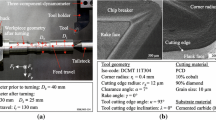Abstract
The use of dry cutting is associated with considerable thermal loads on the machine tool, the tool and the workpiece because of the missing heat convection through the cutting fluid. These thermal loads cause thermal expansions of the components. The accuracy of machining is thus decreased. In recent years, particularly the thermal expansions of the workpiece and the tool attained significance due to the increased demands on the machining accuracy. Aluminum metal matrix composites (Al-MMCs) show a poor machinability due to the reinforcement of light metal alloys via hard and abrasive materials. Dry turning of such composites is therefore accompanied with high thermal workpiece and tool loads. In this paper, finite element models of the workpiece and the tool are used in order to calculate the temperature distribution and thus the thermally induced expansion of the workpiece and the tool when turning AL-MMC regarding the cutting condition used. The removal of material and the heat flow to the environment are considered. The required boundary conditions (e.g. the heat flow into the workpiece) for the simulations were determined using experimental results. A new evaluation method of experimental diameter measurement validates the numerically calculated diameter deviations and reveals a considerable effect of the thermal expansions of the workpiece and the tool on the accuracy of machining.
















Similar content being viewed by others
References
Aurich JC, Zimmermann M, Schindler S, Steinmann P (2014) Analysis of the machining accuracy when dry turning via experiments and finite element simulations. Prod Eng Res Dev 8(1–2):41–50
Bhushan R, Kumar S, Das S (2010) Effect of machining parameters on surface roughness and tool wear for 7075 Al alloy SiC composite. Int J Adv Manuf Technol 50(5–8):459–469
Bian R, He N, Li L, Zhan Z, Wu Q, Shi Z (2013) Precision milling of high fraction SiCp/Al composites with monocrystalline diamond end mill. Int J Adv Manuf Technol 71(1–4):411–419
Biermann D, Iovkov I (2013) Modeling and simulation of heat input in deep-hole drilling with twist drills and MQL. Procedia CIRP 8:87–92
Jianliang G, Rongdi H (2005) A united model of diametral error in slender bar turning with a follower rest. Int J Mach Tool Manuf 46:1002–1012
Joliet R, Byfut A, Surmann T, Schröder A (2013) Validation of a heat input model for the prediction of thermomechanical deformations during NC milling. Procedia CIRP 8(4):403–408
Klocke F, Lung D, Puls H (2013) FEM-modelling of the thermal workpiece deformation in dry turning. Procedia CIRP 8:239–244
Loehe J, Zaeh M (2014) A new approach to build a heat flux model of milling processes. Procedia CIRP 24:7–12
Macherauch E, Müller P (1961) Das \(\sin ^2\psi\)-Verfahren der röntgenographischen Spannungsmessung. Z Angew Phys 13(7):305–312
Moriwaki T, Horiuchi A, Okuda K (1990) Effect of cutting heat on machining accuracy in ultra-precision diamond turning. CIRP Ann Manuf Technol 39(1):81–84
Muguthu J, Dong G (2013) Profile fractal dimension and dimensional accuracy analysis in machining metal matrix composites (MMCs). Mater Manuf Process 28(10):1102–1109
Niederwestberg D, Denkena B (2014) Simulation of thermal and mechanical workpiece load. CIRP J Manuf Sci Technol 7(4):315–323
Pabst R (2008) Mathematische Modellierung der Wärmestromdichte zur Simulation des thermischen Bauteilverhaltens bei der Trockenbearbeitung. Dissertation. Dissertation, University of Karlsruhe
Ramesh R, Mannan M, Poo A (2000) Error compensation in machine tools a review part I: geometric, cutting-force induced and fixture-dependent errors. Int J Adv Manuf Technol 40(9):1235–1256
Ramesh R, Mannan M, Poo A (2000) Error compensation in machine tools a review part II: thermal errors. Int J Adv Manuf Technol 40(9):1257–1284
Sahin Y (2005) The effects of various multilayer ceramic coatings on the wear of carbide cutting tools when machining metal matrix composites. Surf Coat Technol 199(1):112–117
Schindler S, Zimmermann M, Aurich JC, Steinmann P (2014) Finite element model to calculate the thermal expansions of the tool and the workpiece in dry turning. Procedia CIRP 14:535–540
Schindler S, Zimmermann M, Aurich JC, Steinmann P (2014) Thermo-elastic deformations of the workpiece when dry turning aluminum alloys - a finite element model to predict thermal effects in the workpiece. CIRP J Manuf Sci Technol 7(3):233–245
Sölter J, Gulpak M (2012) Heat partitioning in dry milling of steel. CIRP Ann Manuf Technol 61(1):87–90
Stephenson D, Barone M, Dargush G (1995) Thermal expansion of the workpiece in turning. Trans ASME, J Eng Ind 117(4):1102–1109
Sukaylo V, Kaldos A, Pieper H, Bana V, Sobczyk M (2005) Numerical simulation of thermally induced workpiece deformation in turning when using various cutting fluid applications. J Mater Process Technol 167(2–3):408–414
Tomac N, Tannessen K, Rasch F (1992) Machinability of particulate aluminium matrix composites. CIRP Ann Manuf Technol 41(1):55–58
Zhou J, Anderson M, Stahl J (2004) Identification of cutting errors in precision hard turning process. J Mater Process Technol 153–154:746–750
Zhou L, Wang Y, Ma Z, Yu X (2014) Finite element and experimental studies of the formation mechanism of edge defects during machining of SiCp/Al composites. Int J Mach Tool Manuf 84:9–16
Zimmermann M, Schindler S, Steinmann P, Aurich JC (2014) Drehen metallischer Verbundwerkstoffe—Einfluss von Prozessparametern und Verstärkungsphase auf die Fertigungsgenauigkeit. wt Werkstattstechnik online 104(1–2):33–39
Acknowledgments
The authors would like to thank the German research foundation (DFG) for funding the project "Thermal effects when turning Al-MMC - experiments and simulations" AU 185/26, STE 544/42 within the priority program SPP 1480 and the state research focus advanced materials engineering (AME) at the university of Kaiserslautern.
Author information
Authors and Affiliations
Corresponding author
Rights and permissions
About this article
Cite this article
Schindler, S., Zimmermann, M., Aurich, J.C. et al. Identification of thermal effects on the diameter deviation of inhomogeneous aluminum metal matrix composite workpieces when dry turning. Prod. Eng. Res. Devel. 9, 473–485 (2015). https://doi.org/10.1007/s11740-015-0629-4
Received:
Accepted:
Published:
Issue Date:
DOI: https://doi.org/10.1007/s11740-015-0629-4




